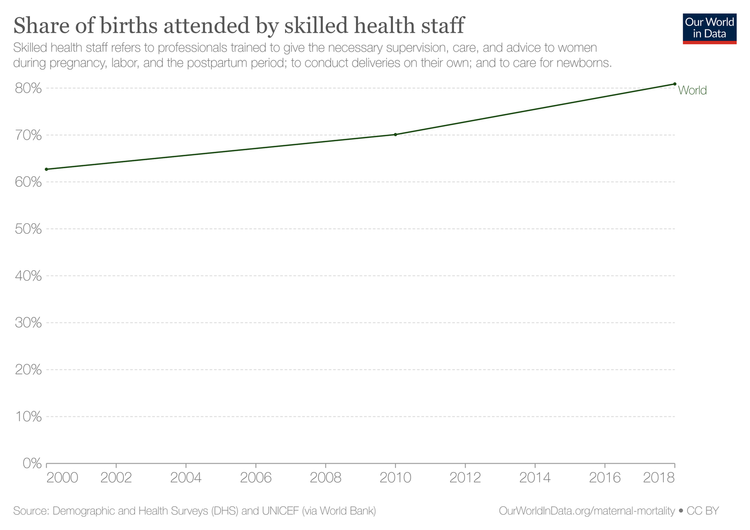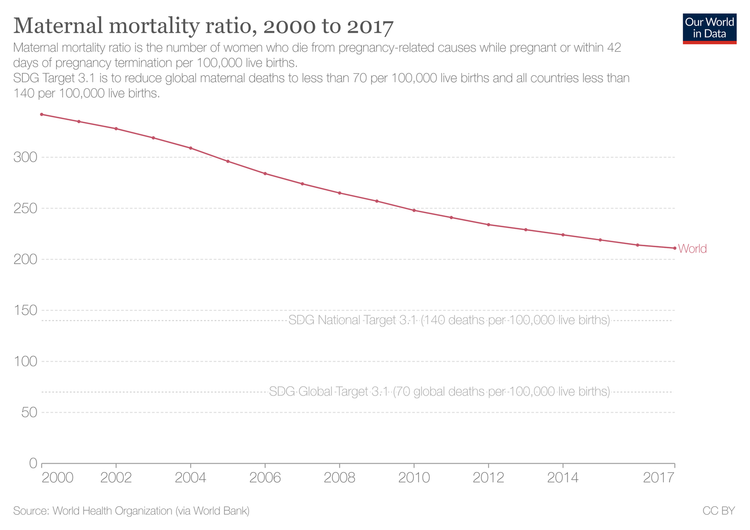SDG #3 is to “To ensure healthy lives and promote well-being for all at all ages.”
Within SDG #3 are 13 targets, of which we here focus on Target 3.1:
By 2030, reduce the global maternal mortality ratio to less than 70 per 100,000 live births.
Target 3.1 has two indicators:
Indicator 3.1.1: Maternal mortality ratio
Indicator 3.1.2: Proportion of births attended by skilled health personnel
The causes of maternal death are manifold. Many of the deaths relate to complications of the cardiovascular system of the blood vessels and the heart. These include postpartum bleeding, which can be treated with intravenous blood transfusion in countries and communities where healthcare coverage is sufficient to offer this.
Mothers can experience high blood pressure in their arteries as a result of the pregnancy, in some instances identified by proteinuria, an abundance of proteins found in the urine. High blood pressure accompanied by proteinuria may indicate a form of high blood pressure related to pregnancy known as pre-eclampsia.
Strokes are possible, whereby blood flow is unable to reach the brain in sufficient amounts, leading to the death of cells. Likewise, embolisms can form in the pulmonary artery, impeding the heart from sending blood toward the lungs.
Other reasons can include obstructed labour and unsafe abortions.
In countries with high prevalence of HIV/AIDS, this is the leading cause of death during pregnancy and postpartum.
Relevant to this, those countries with low GDP per capita are more likely to have less healthcare coverage, making poverty an obvious risk factor for maternal mortality. Another risk factor related to this is the fertility rate, reflecting a phenomenon whereby the birth rates of poor countries are higher because of the poverty trap. When compounded by low health care coverage in these countries, a high fertility rate, low levels of income and low health care coverage form a recipe for high maternal mortality rates.
In terms of prevention of maternal deaths, complications in the term of a pregnancy, childbirth and the postpartum period can be mitigated by the presence of skilled birth attendants, in communities where doctors specialised in obstetrics and gynaecology are absent.
Other worthwhile preventions are family planning methods and birth control, to prevent unwanted pregnancies putting a potential mother at risk of death.
Prenatal care can also act as a form of preventive healthcare
Healthcare coverage also tends to ensure an aseptic medical environment, free of pathogenic bacteria, viruses, fungi and parasites which cause septic infections in tissues from these pathogens
Complementing the existence of health care coverage are public health campaigns, which can promote preventive behaviours and mitigate the risks of maternal death.
The Millenium Development Goals, the UN goals which preceded the SDGs, had an entire goal devoted to maternal health. Millenium Development Goal #5 set the objective to improve maternal health. Target #5A of the MDGs corresponds with the SDG target we’re looking at here, focused upon the maternal mortality ratio. Target #5A was to “Reduce by three-quarters, between 1990 and 2015, the maternal mortality ratio”
In setting a global standard for diagnosing health issues, the World Health Organisation classifies diseases according to the International Statistical Classification of Diseases and Related Health Problems (ICD). According to this classification, maternal death is defined as deaths occurring whilst a mother is pregnant, or within 42 days following the termination of the pregnancy.
The most recent global data for maternal mortality ratio is from 2017, 211 maternal deaths per 100,000 live births, down only a little from the 2015 baseline of 219 per 100,000, and 342 per 100,000 from the start of the MDG period in 2000. To reach this target’s objective, we need to reduce this down to 70 maternal deaths per 100,000 live births by 2030.
To offer an example of a country which is on has achieved this target, and is on track to achieve SDG #3 overall, Australia had a maternal mortality ratio in 2020 of 5.5 deaths per 100,000, or the equivalent of 16 maternal deaths.
The proportion of births attended by skilled health attendants worldwide is 80% as of 2018, up from 62% in 2000.



